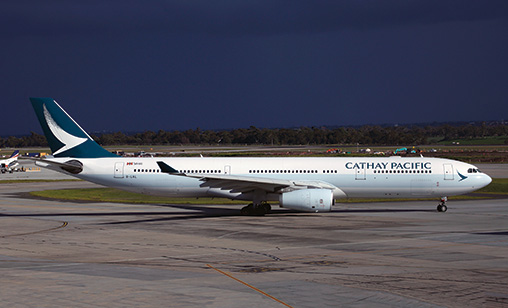Industry Insight Special Report
MRO transformed by Big Data
June 1st 2017
Two of Asia’s major airlines are the first carriers in the world to sign up for a maintenance service program that utilizes connectivity and data analytics to improve maintenance quality and reduce airline downtime. Read More »
Last year, Cathay Pacific Airways became concerned its aircraft cabins were too hot during the Hong Kong summer so it approached major avionics and software giant, Honeywell, to solve the problem.
 |
Scientists from the U.S. company and other industry experts got to work and developed a software solution to the problem which they tested on Cathay Pacific’s 61 A330s. The results were little short of astounding.
Using existing data links on the aircraft, successful analysis of trial data returned a 35% reduction in operational disruptions, with a false positive rate of less than 1%. The new system saved the airline several hundred thousand dollars in the operation and cost of maintenance of a single aircraft system, the auxiliary power unit (APU), a unit produced by Honeywell and also its aerospace competitors.
After the successful test program concluded, Cathay Pacific signed on the dotted line for Honeywell’s new GoDirect Maintenance Service for its A330 fleet and is considering an extension of the software diagnosis system to its B777s.
The Hong Kong carrier’s fleet will be outfitted with Honeywell’s Connected Auxiliary Power Unit (APU) predictive maintenance service that will identify potential mechanical issues or failures before they happen. China’s Hainan Airlines’ fleet of more 50 A330s will be similarly equipped. The aerospace company also will install the system on Hainan’s on order 40 A330s.
Honeywell vice president airlines Asia Pacific, Brian Davis, said the deals were monumental and not only for Cathay Pacific and Hainan Airlines “but for the aerospace industry as it undergoes a digital transformation that is changing the industry as we know it”.
The Connected APU service works by using an existing data connection on the plane to download APU maintenance and fault data to predict impending hardware failures. Those failures are routinely the highest cause of APU interruptions. That data is then shared with Honeywell and analyzed and then presented to an airline’s maintenance team in an easy-to-understand, visual manner. The data identifies faults in the APU, avoiding an unscheduled maintenance event.
How did Honeywell achieve the results? “We asked why the APU was shutting down. We found that the predictive trend monitoring that existed in the industry, not only for Honeywell but for our competition, looked at the core engine,” said Davis.
“That’s important for cost, but typically the core engine was not the cause of a line maintenance interruption in the operational day. It’s almost always the line replaceable units, the LRUs, the components that are on the APU.
“We took months and months of data and interpreted it. We accomplished all of this without adding any sensors or a single ounce of weight to the aircraft. It was just looking at the data. A lot of smart people put their heads together and came up with an algorithm that predicts [an APU problem] with a less than 1% false failure rate.”
“Honeywell’s GoDirect Maintenance Services offering helps us maintain this commitment by reducing the number of auxiliary power unit downtime events and improving our first-time fix rate. We plan to explore how to expand the offering to additional aircraft systems,” said a Cathay Pacific spokesman.
Hainan’s Airline’s chairman, Xie Haoming, said the Honeywell system “reduces downtime, keeping our planes in the air more often to transport our passengers to their destinations safely and on time”.
Davis said the data analytics could be extended to an aircraft’s brake system. “We can the way airlines use their brakes and recommend the best combination of brake energy and brake wear for the alternate cost savings,” he said.
The aircraft’s environmental control system (ECS) could be part of the system. “In areas where you have air contamination, for example in some parts of China, airlines can carry out preventive maintenance before an ECS system becomes clogged. It could avoid a significant delay and probably a cancellation,” he said.
Davis said we are just starting “to press the edge of “Big Data”. “Honeywell has a huge amount of content on both the A350 and B787. We are taking off about 844 terabytes of data in a 12-hour flight. That’s about 27,000 32 gigabyte iPhone 7s fully working at the same time. That is potential of information we can pull off these aircraft.”
“With some of this Big Data, if I can know real-time winds and temperatures then ultimately an airline could save 2%-4% on its fuel bill. All of a sudden, the light goes on at airlines about the meaning and value of Big Data,” he said.